Create Microsoft lists to keep track of information, including titles, descriptions, people and dates.
You can create and share lists that help you track issues, assets, routines, contacts, inventory, and more. Start from the Microsoft Lists app, Microsoft Teams, or SharePoint using a template, Excel file, or from scratch.
You can create lists in Microsoft SharePoint, the Lists app in Microsoft 365, or Teams. Learn to get started with Lists in Microsoft Teams.
Tip: To learn more about data and lists, check out these YouTube videos from Microsoft Creators!
Create a list
Create a list from scratch, from an Excel spreadsheet, from an existing list, or from one of Microsoft 365 ready-made templates.
-
Go to the SharePoint site where you want to create a list.
-
Or in Microsoft Teams, from the Files tab at the top of your channel, select More > Open in SharePoint.
-
-
On the Site contents page, select New > List.
-
Or in the Microsoft Lists app, select + New List.
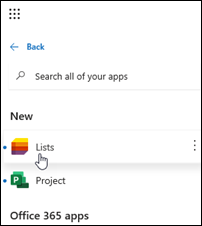
-
-
From the Create a list page, select one of the following options:
-
Blank list: Choose this option to start from scratch. Give your list a Name, Description (optional), and select any other options you want. The list will save to My lists unless you choose one of your SharePoint sites or Teams from the Save to list. When you're finished selecting options, select Create.
-
From Excel: Choose this option to Create a list based on an Excel spreadsheet.
-
From existing list: Choose this option to save time and create a new list based on the columns in another list. Your new list will start with all the same columns, but it won't include any of the data from the original list.
-
Templates: Select a template, for example Issue tracker, to see what columns the template contains and scroll through sample data to see what it looks like. Select other templates to look at other ones. If you find one you like, select Use template. If you don't see any you like, select Back to get back to the Create a list page. To learn more, see Using Microsoft Lists templates.
-
-
When your list opens, to add room for more types of information to the list, select + or + Add column.
To change properties, delete the list, add permissions, manage columns, and a number of other updates, select Settings  , and then select List Settings. For more info, see Edit a list.
, and then select List Settings. For more info, see Edit a list.
Learn more
For more info about adding columns, see Create a column in a SharePoint list or library.
For info about creating a list based on an existing list, see Create a new SharePoint list based on the columns in another list.
Create lists from other types of list templates
You can use SharePoint Server 2019 lists for more than a simple list. You can choose from list templates such as Links, Calendar, Survey, Issue Tracking, Announcements, and more. To learn more, see Using Microsoft List templates.
Calendar app example
-
In this example, we used calendar and chose the built-in calendar app for SharePoint. You may see other calendars that have been built within your company or offered by a third party.
-
Enter a Name for the app you chose, such as Event calendar, July tasks, or Company Contacts.
The name appears at the top of the list in most views, becomes part of the web address for the list page, and appears in site navigation to help users find the list. You can change the name of a list, but the web address will remain the same.
-
SharePoint returns you to the Site contents page. Find the app you just created in the Site contents list, and open it. SharePoint creates a default version of the app, calendar, task list, or whatever app you created.
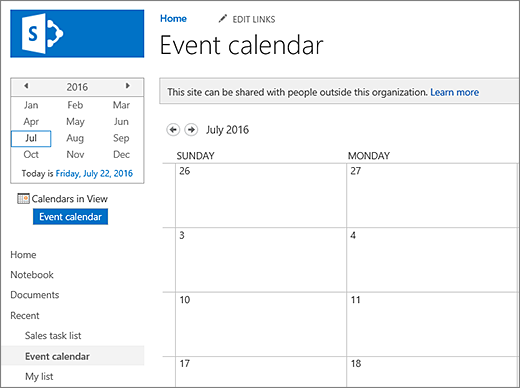
-
You can start entering data using +new task, edit this list, Add, or whatever way the specific app provides to add data.
Note: Some list-based apps only appear in the classic environment.
Depending on the type of app you choose, to change the app's settings, from the ribbon at the top of the page, select List Settings or the List tab. For more info about settings, see Edit list settings in SharePoint.
Create a list in SharePoint Server 2016 or SharePoint Server 2013
-
Select Settings
 , and then select Add an app.
, and then select Add an app.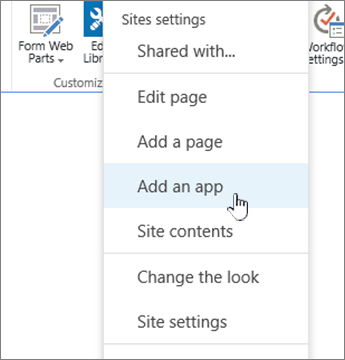
-
Enter the type of list template you want (custom, task, calendar, and so on) into the search box, and select Search
 .
.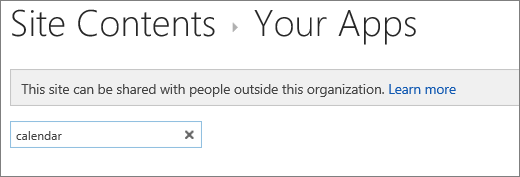
-
Select the List template app you want use.

-
Enter a Name (required).
The name appears at the top of the list in most views, becomes part of the web address for the list page, and appears in site navigation to help users find the list. You can change the name of a list, but the web address will remain the same.
To provide an optional Description and additional info, depending on the particular list app, select Advanced Options. Advanced Options.
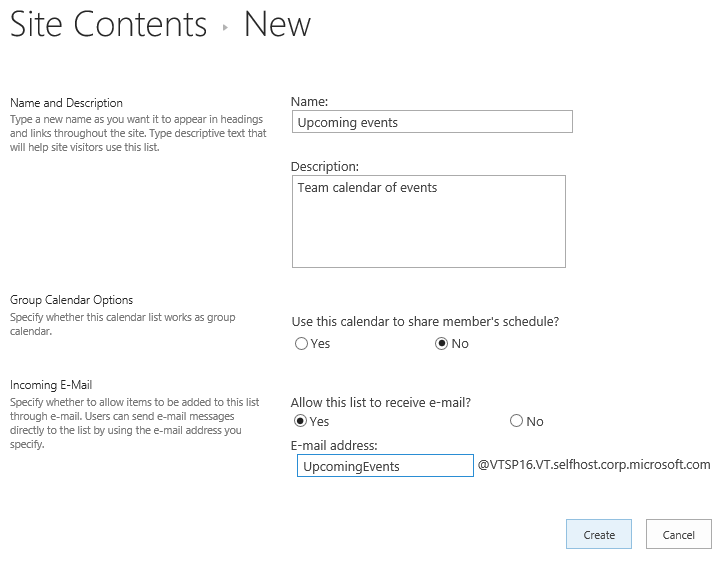
-
Select OK.
Add a list to a page in SharePoint Server 2016 or SharePoint Server 2013
-
On the page that you want to add the list or library, select Page, and then select Edit. If you don't see the Page tab, select Settings
 , and then select Edit Page.
, and then select Edit Page.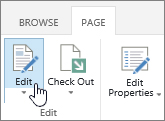
Note: If the Edit command is disabled or doesn't appear, you may not have permission to edit the page.
-
Select the place on the page where you want the list or library to appear, select Insert, and then select App Part.
-
For the list or library, select the App Part, and then select Add. In Add apps, any lists you created should appear.
-
When you're finished editing the page, select the Page tab, and then select Save. In some cases, you have the option to Save as Draft or Save and Publish.
Important: Some pages can't be edited, such as the Site Contents page.
Using the previous steps, here's an example of a list that was added to a page.
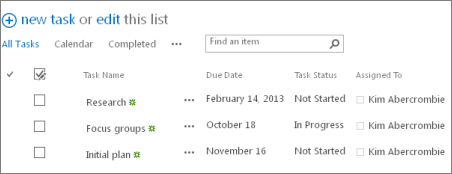
Minimize or restore a list or library on a SharePoint Server 2016 or SharePoint Server 2013 page
-
On the page where you want to minimize or restore the list or library, select Page, and then select Edit.

-
Point to the list or library, select the down arrow, and select Minimize or Restore depending on the current position of the list or library, and then select OK.
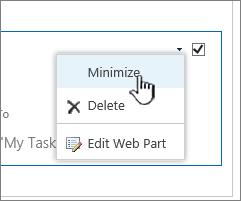
-
When you're finished editing the page, select Save. In some cases, you have the option to Save as Draft or Save and Publish.
Create a list in SharePoint Server 2010
You can create a list that you can later use in your pages. SharePoint Server 2010 includes many kinds of list templates, such as calendar, survey, and tasks.
-
Select Site Actions
 , select View All Site Content, and then select Create
, select View All Site Content, and then select Create  .
.Note: A SharePoint site can be significantly modified. If you cannot locate an option, such as a command, button, or link, contact your administrator.
-
Select one of the categories, such as Communications or Tracking, and choose from there.
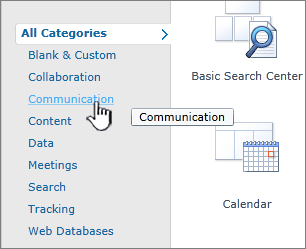
You can also enter the type of list template that you want to create in the Search Installed Items box, such as Contacts or Calendar, and then select Search
 .
. -
Enter the Name for the list. Name is required.
The name appears at the top of the list in most views, becomes part of the web address for the list page, and appears in site navigation to help users find the list. You can change the name of a list, but the web address will remain the same.
-
Optionally, for the list and set other options, click Advanced Options, and enter the Description.
The description appears underneath the name in most views. Some kinds of lists can receive content by email. If you plan to enable the list to receive content by email, you can add the email address of the list to its description so that people can easily find the email address. You can change the description for a list.
-
To add a link to the Quick Launch panel, in the Navigation section, verify that Yes is selected.
-
If there is an Email section, your administrator has enabled lists on your site to receive content by email. To enable people to add content to this list by sending email, under Enable this list to receive email, select Yes. Then, in the Email address box, enter the first part of the address that you want people to use for the list. This option is not available for all kinds of list.
-
Complete any other options, such as specifying whether a calendar works as a group calendar in the Calendar app.
-
Select Create.
Create a list on a page in SharePoint Server 2010
With SharePoint Server 2010 you can create lists from the pages that you are editing. This helps you more efficiently and effectively create the pages and the lists that you need.
-
From a page, select the Edit tab, and then select the Edit command.
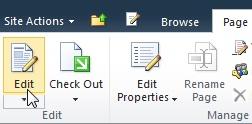
Note: If the edit command is disabled, you may not have the permissions to edit the page, contact your administrator.
-
Select the page where you want to add a new list, select the Insert tab, and then select New List.

Note: If you don't see the Edit tab or New List is disabled, you may not have the permissions that are needed to create a list; contact your administrator.
-
In the Create List dialog, enter the List Tile, select the type of list that you want to create, and then select OK.
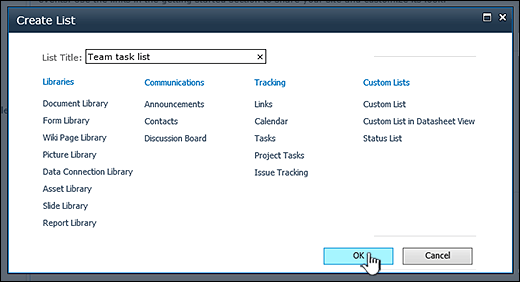
Create a custom list in SharePoint Server 2010
Creating a custom list resembles creating lists from a template, except that the custom list is created with only three columns: Title, Created By, and Modified By. After you create a custom list, you can add columns and make other changes to the list to meet your needs.
-
Select Site Actions
 , select View All Site Content, and then select Create
, select View All Site Content, and then select Create  .
.Note: A SharePoint site can be significantly modified. If you cannot locate an option, such as a command, button, or link, contact your administrator.
-
Under Custom Lists, select Custom List or Custom List in Datasheet View.
Notes:
-
Use custom list when you primarily want to use a form to enter and view data in the list.
-
Use custom list in datasheet view when you primarily want to use a grid, similar to a spreadsheet, to enter and view data in the list. This is helpful when you have several items to update at the same time.
-
You can change how you enter and display data in a list after a list is created.
-
-
Enter the Name for the list. Name is required.
The name appears at the top of the list in most views, becomes part of the web address for the list page, and appears in site navigation to help users find the list. You can change the name of a list, but the web address will remain the same.
-
Enter the Description for the list. (Optional)
The description appears underneath the name in most views. Some kinds of lists can receive content by email. If you plan to enable the list to receive content by email, you can add the email address of the list to its description so that people can easily find the email address. You can change the description for a list.
-
To add a link to the Quick Launch, in the Navigation section, verify that Yes is selected.
-
If there is an Email section, your administrator has enabled lists on your site to receive content by email. To enable people to add content to this list by sending email, under Enable this list to receive e-mail, select Yes. Then, in the Email address box, enter the first part of the address that you want people to use for the list. This option is not available for all kinds of list.
-
Select Create.
Add a list to a page in SharePoint Server 2010
-
On the page that you want to add the list or library, select Page, and then select Edit. If you don't see the Page tab, select Settings
 , and then select Edit Page.
, and then select Edit Page.
Note: If the Edit command is disabled or doesn't appear, you may not have permission to edit the page. Contact your administrator.
-
Select the place on the page where the list or library will appear, select Insert, and then select App Part.
-
For the list or library, select the App Part, and then select Add.
-
When you're finished editing the page, select Save. In some cases, you have the option to Save as Draft or Save and Publish.
Using the previous steps, here's an example of a list that was added to a page.

To find out which version of SharePoint you're using, see Which version of SharePoint am I using?
Want to do the same with Libraries?
To create a library, see Create a document library.
Next steps with Lists
Columns Configure what type of info a list holds by adding and deleting columns. For more info, see Create a column in a list or library.
Views Change how a list is displayed by creating views. For more info, see Create, change, or delete a view of a list or library.
No comments:
Post a Comment